
- •1. Concepts of symptoms and syndromes
- •2. Pulmonology
- •1. Syndrome of compaction of lung tissue (decrease in airiness)
- •2. Syndrome of increased airiness of lung tissue (emphysema)
- •3. Broncho obstructive syndrome
- •4. Lung cavity syndrome
- •5. The syndrome of fluid accumulation in the pleural cavity
- •6. The syndrome of accumulation of air in the pleural cavity
- •7. Bronchiectasis Syndrome
- •8. Syndrome of lung atelectasis
- •9. Syndrome of dry pleurisy (pleuritis)
- •10. Respiratory failure syndrome
- •11. Pulmonary heart failure (pulmonary heart)
- •12. Adult respiratory distress syndrome
- •3. Cardiology
- •1. Syndromes of coronary insufficiency
- •2. Angina pectoris syndrome (stenocardia)
- •4. Myocardial damage syndrome
- •5. Resorption-necrotic syndrome
- •6. Post-infarction syndrome (Dressler's syndrome).
- •7. Аrterial hypertension Syndrome (ah)
- •8. Arterial hypotension syndrome
- •9. Heart failure syndrome
- •V.Kh. Vasilenko (1935).
- •10. Cardiomegaly syndrome
- •Syndrome of fluid accumulation in the pericardium (hydropericardium) The reasons for the accumulation of exudate:
- •12. Rhythm and conduction disturbances syndromes
- •I. Arrhythmias due to a violation of the automatism of the sinus node:
- •Atrial flutter (irregular and regular forms). Symptoms
- •Ventricular flutter and fibrillation. Symptoms
- •IV. Conductivity disorders - blockade:
- •13. Syndromes of valvular heart disease.
- •14. Mitral valve prolapse
- •15. Syndrome of hypertension of the pulmonary circulation
- •16. The syndrome of acute vascular insufficiency
- •4. Gastroenterology
- •4.1. Syndromes for diseases of the esophagus, stomach and gut
- •1. Dysphagia Syndrome
- •Gastroduodenal pain syndrome
- •3. Gastric hypersecretion syndrome
- •4. Gastric hyposecretion syndrome
- •5. Syndrome of gastric evacuation
- •6. Functional dyspepsia syndrome:
- •Bleeding syndrome from the lower gastrointestinal tract
- •9. The syndrome of "acute abdomen"
- •10. Dyspeptic syndrome (indigestion)
- •11. Irritable bowel syndrome:
- •2. Pain abdominal syndrome:
- •13. Asthenoneurotic syndrome:
- •4.2 Syndromes for diseases of the liver and bilitary ways
- •1. Biliary colic syndrome
- •2. Subhepatic jaundice (mechanical)
- •3. Hepatic jaundice (parenchymal)
- •4. Suprahepatic jaundice (hemolytic)
- •6. Cholestatic syndrome
- •8. Hypersplenism syndrome
- •9. Portal hypertension
- •10. Hepatic failure syndrome
- •12. Cytolysis syndrome (cytolytic syndrome)
- •13. Mesenchymal inflammatory syndrome
- •1. Pancreatic pain syndrome
- •1. The insufficiency of exocrine pancreatic function
- •Syndrome of pancreatic incretory function.
- •5. The syndrome of gastric pancreatic dyspepsia:
- •1. Renal colic syndrome
- •2. Urinary Syndrome
- •4. Nephrotic syndrome
- •5. Acute nephritic syndrome (acute glomerulonephritis)
- •Chronic nephritic syndrome (chronic glomerulonephritis)
- •7. Edema syndrome (renal edema)
- •Hypertension Syndrome
- •9. Renal eclampsia syndrome
- •Acute renal failure (arf)
- •11. Chronic renal failure
- •6. Endocrinology
- •1. Syndrome of hypothyroidism:
- •Thyrotoxicosis syndrome (hyperthyroidism):
- •3. The syndrome of insulin deficiency:
- •1. Anemic syndrome
- •2. Sideropenic syndrome (iron deficiency)
- •Iron deficiency anemia
- •Hemolytic anemia
- •6. Hemorrhagic syndrome
- •7. Inflammatory syndrome
- •Neurological syndrome
- •10. Immunodeficiency syndrome
- •Leukemia syndrome (hemoblastosis) 11.1 Acute Leukemia Syndrome
- •11.2 Chronic myeloproliferative syndrome
- •11.3 Chronic lymphoproliferative syndrome
- •2. Disseminated intravascular coagulation syndrome
- •Urticaria syndrome
- •2. Quincke's angioedema
- •3. Anaphylactic shock
- •4. Joint syndrome
- •9. The meaning of eponymous terms and syndromes in clinical medicine
Atrial flutter (irregular and regular forms). Symptoms
1) the number of pulses does not exceed 250-300 per min .;
2) pulses through the atrioventricular node are conducted more rhythmically than with atrial fibrillation.
3) The clinically irregular form does not differ from atrial fibrillation. With a regular form, the pulse and heart rate are rhythmic.
4) ECG: Irregular shape - the same signs as with atrial fibrillation, but the f waves are of high amplitude - ―saw teeth‖.
5) The regular shape is distinguished by the same R-R intervals.
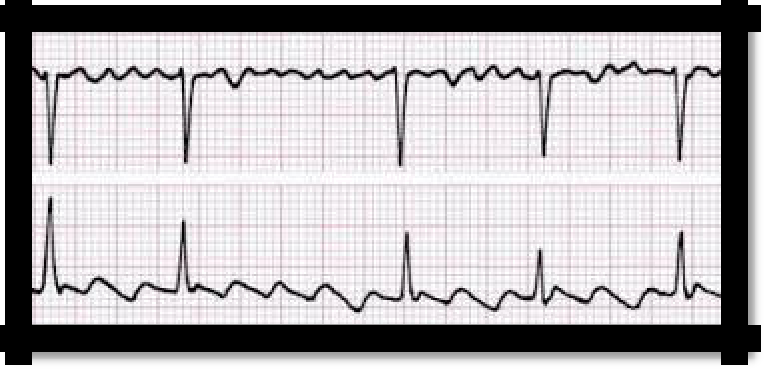
Pic 3.12 Atrial fibrillation (upper) and atrial flutter (lower)
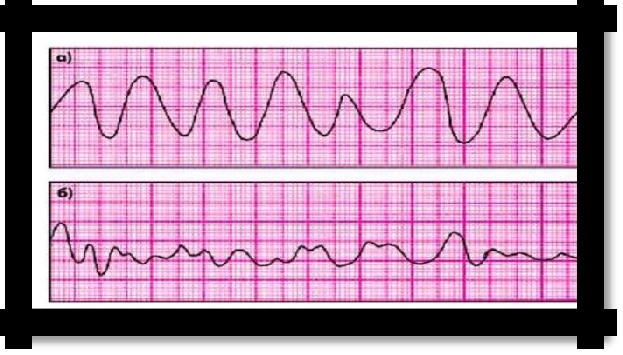
Pic 3.13 ventricular flutter and fibrillation
Ventricular flutter and fibrillation. Symptoms
faint;
pallor of the skin;
pulse and blood pressure are not determined;
39
ECG: individual disordered deformed complexes, on which it is difficult to distinguish individual teeth.
IV. Conductivity disorders - blockade:
sinoauricular;
atrial;
atrioventricular I, II, III degree;
g) intraventricular.
a) sinoauricular block. Symptoms
with auscultation of the heart and palpation of the pulse, periodic loss of heart beat and pulse beat is detected. On the ECG: against the background of the correct sinus rhythm, periodically, cardiac complex falls out (the P wave and QRS complex are not recorded), the duration of the diastole doubles.

Pic 3.14 Sinoauricular block
b) Atrial block. Symptoms
It is detected only electrocardiographically. ECG: there is a change in the P waves, they are deformed, their duration exceeds normal conductivity - up to 0.1 s.

Pic 3.15 Atrial block
c) Atrioventricular. Symptoms
I degree - detected only electrocardiographically by lengthening the P-Q interval of more than 0.2 s;
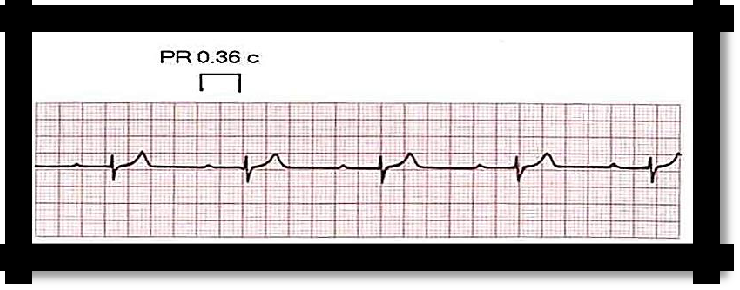
Pic 3.16 I degree
40
degree: type 1 or Mobitz I in case of violation (deceleration) of atrioventricular conduction up to the complete blocking of the pulse.
1) a feeling of "freezing" or a stop in the work of the heart;
2) slight dizziness;
3) with auscultation and palpation of the pulse - periodic loss of heart beat and pulse beat;
4) ECG: gradual lengthening of the P-Q interval until the ventricular QRS complex falls out (Samoilov-Wenckebach periods)
.

Pic 3.17 II degree: type 1 or Mobitz I
Type 2 or Mobitz II is characterized by a constant duration of the P-Q interval with periodic loss of the QRST complex.
"Fading", "interruptions", "stop" in the work of the heart;
dizziness, darkening in the eyes, short-term loss of consciousness;
heart contractions and pulse are rare, arrhythmic.
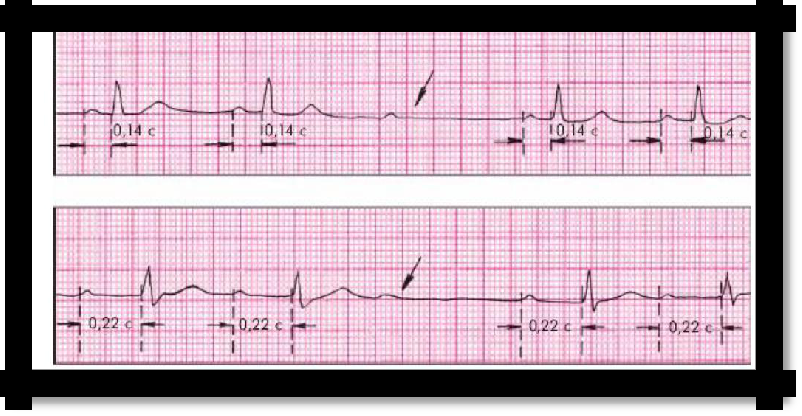
Pic 3.18 Type 2 or Mobitz II
AV blocks of the II degree 2: 1 are also secreted when every second ventricular contraction falls out, while the pulse remains rhythmic.
degree of blockade (complete transverse blockade of the heart). The atrium contracts under the guidance of the sinus node, and the ventricles - atrioventricular, independent of each other.
1) a rare rhythmic pulse, large in size, heart rate - 30-45 in 1 min. ;
2) increased heart size due to diastolic overflow with its blood;
3) heart sounds are muffled, but loud I tone can be periodically determined (―cannon tone‖ of Strazhesko);
4) Morgagni-Edems-Stokes syndrome, caused by a violation of the regional blood circulation of various organs, primarily Ts.N.S. as a result of the loss of not one, but several contractions of the heart in a row:
41
sudden loss of consciousness, the patient falls; with a duration of fainting of 15-20 seconds. general muscle cramps (epileptiform) occur;
deep breathing, pallor of the skin;
ECG: P wave without communication with QRST, correct P wave alternation, correct Q-T alternation (R-R are equal to each other, but R-R is longer than R-P).
Pic 3.18 III degree of blockade

d) Intraventricular block. Symptoms:
With auscultation of the heart, splitting or bifurcation of tones due to asynchronism in the activity of the ventricles.
Allocate: Complete and incomplete blockade of the right and left legs, left anterior and left posterior legs of the bundle of His.
CAUSES, Congenital conduction disorders and acquired due to heart disease.
Signs of a full leg block:
expansion of the QRS complex for more than 0.11 seconds, discordance of the T wave and QRS complex
With blockade of the right leg in leads V1, V2, R is high (R, RSr types) and the T wave is negative.
With blockade of the left leg, QS prevails in leads V1, V2 and the T wave is positive
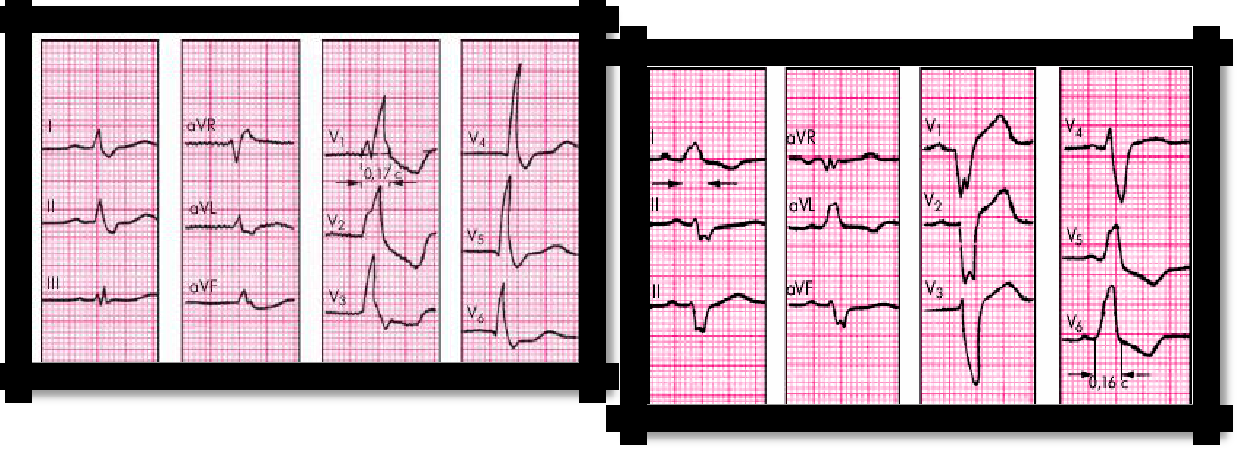
Pic 3.19 Right bundle branch block Pic 3.20 Left bundle branch block
Generalized heart rhythm and conduction disorder syndrome
42
REASONS: any diseases and dysfunction of the heart; reflex effects on cardiac conduction and automatism.
GENERAL SYMPTOMS:
complaints of palpitations, interruptions in the work of the heart, a feeling of "freezing", "stopping" of the heart, sometimes followed by a strong blow (with extrasystole);
irregular heartbeat, tachycardia, bradycardia;
pulse deficiency (most characteristic for atrial fibrillation);
irregularity of tones during auscultation, polyphony of I tone at the apex (atrial fibrillation), ―cannon‖ tone of Strazhesko (complete atrioventricular block), premature contraction of the heart with a characteristic loud I tone, periodic loss of tones (with blockade);
heart rhythm disturbance, especially paroxysmal, can provoke acute coronary, cardiac or vascular insufficiency, or aggravate chronic forms thereof;
the type of arrhythmia or blockade can be finally verified using an ECG.
